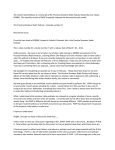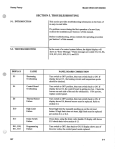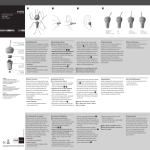Download User`s Manual
Transcript
User’s Manual TX-300V Studio Transmitter Phonak Communications AG Laenggasse 17 3280 Murten Switzerland T +41 (0) 26 672 96 72 F +41 (0) 26 672 96 77 [email protected] www.phonakcom.ch Welcome to Phonak TX-300V Studio Transmitter Package Contents • • • • • • i TX-300V Studio Transmitter Power Supply User’s Manual Telescoping Antenna Radials (2) Antenna Mounting Assembly 50 Ohm Coaxial Cable (7.6m) Phonak Part Number 116-1938 Optional Accessories Rack Mount Kit (part number 116-1940, see page 14) Phonak™ and the Phonak Logo are registered trademarks of Phonak Communications AG. TX-300V_2006_01_20 © 2006 Phonak Communications AG. All Rights Reserved. Specifications. . . . . . . . . . . . . . . . . . . . . . . . . . . . . . . . . . . . . . . . . . . . . . . . . . . . . . . 4 Block Diagram . . . . . . . . . . . . . . . . . . . . . . . . . . . . . . . . . . . . . . . . . . . . . . . . . . . . . . 5 Quick Reference . . . . . . . . . . . . . . . . . . . . . . . . . . . . . . . . . . . . . . . . . . . . . . . . . . . . 6 Setup Instructions . . . . . . . . . . . . . . . . . . . . . . . . . . . . . . . . . . . . . . . . . . . . . . . . . . . 7 Operating Instructions. . . . . . . . . . . . . . . . . . . . . . . . . . . . . . . . . . . . . . . . . . . . . . . . 9 Audio Control . . . . . . . . . . . . . . . . . . . . . . . . . . . . . . . . . . . . . . . . . . . . . . . . . . . . . . 9 RF Reception Maximization Strategies. . . . . . . . . . . . . . . . . . . . . . . . . . . . . . . . . . 10 Troubleshooting. . . . . . . . . . . . . . . . . . . . . . . . . . . . . . . . . . . . . . . . . . . . . . . . . . . . 11 Compliance Notice . . . . . . . . . . . . . . . . . . . . . . . . . . . . . . . . . . . . . . . . . . . . . . . . . 12 Warranty . . . . . . . . . . . . . . . . . . . . . . . . . . . . . . . . . . . . . . . . . . . . . . . . . . . . . . . . . 13 Optional Accessories . . . . . . . . . . . . . . . . . . . . . . . . . . . . . . . . . . . . . . . . . . . . . . . . 14 Table of Contents Table of Contents Specifications Specifications RF Audio Controls Indicators Power Physical Environmental 4 Frequency Accuracy /-.005% stability 0 to 50C Transmitter Stability 50 PPM Output Power 50mW, 100mW, 300mW (Actual power for each frequency set by Phonak) Antenna Dipole Antenna (Included with Transmitter) Antenna Connector BNC Compliance FCC Part 15, Industry Canada, RoHS System Distortion <2% total harmonic distortion (THD) at 80% deviation Audio Input 1 Rear panel. Female-XLR and phone combo connector, balanced. 0/-55 dBu (line/mic) nominal input level adjustable Audio Input 2 Rear panel, (2) Phono connectors, unbalanced, -10/+10 dBu nominal input level adjustable, +30 dBu maximum, impedance 100k ohms Combined Audio Output (Mix) Rear panel, (2) Phono connectors, unbalanced, 0 dBu nominal output level, +19 dBu maximum, impedance 10 ohms Headphone Output Front panel, (1) 3.5 mm connector, unbalanced, adjustable output level Front Panel Power, Test Tone on/off, Channel up/down, Input Level, Mix Level, Contour, Headset Level Rear Panel Input 1 Level (Line, Mic, Mic-Phantom Power), Input 2 Level (-10/+10 dBu), RF Power (low, mid, high) Internal Adjustments Compression ratio for audio processor Programming Processing on/off Input 1 and Input 2, Mix VU Meters 8 Green, 2 Red Processing Indicated by a green LED when on RF Power Indicated on the LCD Display Power Red LED illuminates when the unit is powered up LCD Display Channel designation, lock status, RF Power Level, programming Test Tone Red LED illuminates when test tone enabled Power Supply Type In-line power supply Power Supply Input 115/230VAC, 50/60Hz Power Supply Output 12VDC, 1.3 A Power Supply Connector 5.0 mm (.02 in) 2.5 mm (OD x .01 in) ID, barrel type Compliance CE, UL Dimensions W x D x H 20.3 x 20 x 4.45 cm (8.0 x 8.0 x 1.75 in) Unit Weight 1.4 kg (3.0 lbs) Unit Weight with Power Supply 2.0 kg (4.4 lbs) Shipping Weight 2 kg (5.0 lbs) Rack Mounting ½ rack unit, optional rack mount not included. Order Phonak part number 116-1940 Temperature - Operation &)WRÝ) Temperature - Storage &)WRÝ) Humidity 0 to 95% relative humidity, non-condensing Block Diagram TX-300V Block Diagram POWER On RS-232 DB-9 Connector Programming 3.5MM Off Red LED 115/230VAC 50/60 Hz CHANNELSELECT Universal Power Supply (included) MONITOR Up 12VDC, 1.3A Power Supply CPU Module Volume Down Phonak LCD Display MIX Level VU Meter Compression Ratio (internal adjustment) Remote Antenna (included) Pre-emphasis Transmitter RF Modulation Processing ANTENNA MIX LEVEL Low Functions controlled by the CPU Module Mid Green LED On High RF POWER CONTOUR Off PROCESS Input 1 VU Meter Input 2 VU Meter Input Level POT Front Panel 12VDC Input 1 Level Select Line, Mic, Mic-Phantom Pwr Mic Line Mic Phantom Pwr Input 2 Level Select -10dBu, +10dBu +10dBu Test Tone Button Front Panel -10dBu ON OFF Red LED Female XLR - ¼“ Combo Connector 2/Tip 3/Ring Phone Phone 400Hz 1/Sleeve INPUT 1 INPUT 2 MIX OUTPUT TEST TONE All switches are shown in their default positions. 5 Quick Reference Quick Reference TX-300V Front Panel: Controls & Displays Indicates Process Mode is active Adjust audio input levels of Input 1 and Input 2 here. See page 9 for more information Power ON / OFF Test Tone: Activates a tone to aid system setup Indicates audio input level of Input 1 and Input 2 LCD: Shows which channel is selected Shows mixed audio level Mix Level: Adjust so the Mix Level meter occasionally lights the red LED Contour: Equalization adjustment. Turn counterclockwise for voice and clockwise for music Channel Select Up: Press for 3 seconds to lock on current channel Monitor Port: Plug in a headset and adjust volume Channel Select Down: Press for 8 seconds to enter program mode. See page 9 for more information TX-300V Back Panel: Connections & Settings Remote Antenna Connection: See page 8 for details on antennas that can be attached here Mix Output: These connectors contain a mix of Input 1 and Input 2. They are unbalanced phono connectors; and the output level is -10dBu Input 2: Set switch to match the level of your Input 2 audio source. Input 1: Used for balanced connection of a microphone or line level input. This combination connector accepts either XLR or phone connectors Serial Port: Used for programming Set RF Power level here (¼ , ½ and Full). See page 7 for guidelines on setting power levels 6 The power supply connects here Input 2: Connect unbalanced audio to these phono connectors, input level -10dBu or +10dBu Select Line, Mic or Mic+Phantom Power. Line is balanced 0 dBu input level, Mic is -55dBu, +12VDC supplied in PH PWR position. If not using input 1, leave in line position. Setup TX-300V Studio Setup Instructions Unpack the Product Remove outer packaging and plastic cover. Inspect for physical damage. Mount in Rack (if necessary) If rack mounting the unit, install the optional rack mount kit (part 116-1940) according to the instructions included with the kit, then install the TX-300V in the rack. Input 1 Connect the audio source(s) to one or both audio input connections. Input 1 offers a choice of a balanced XLR or phone connector. Back of TX-300V with XLR connected to Input 1 Line Mic Rack Mount with dual unit installed Rack Mount with single unit installed Connect Power Plug the power supply into the power connector on the back panel, then plug the power supply into an outlet. Plug your microphone into Input 1 and move the input select switch to Mic (for dynamic microphones) or Mic + PH Power (for condenser microphones). XLR Wiring Use only the original power supply: - AC Adaptor, Input: 115/230VAC, 50/60Hz and Output: 120VDC, 1.3A, Model SP48-151000A Set RF Power Set the RF POWER switch on the back of the unit to Full, ½ or ¼ (Level is indicated on the LCD display). The amount of transmitted RF power that you will need depends on your application. If you are operating multiple transmitters in the same environment, it is best to set the transmitter’s output power to its lowest level to reduce the possibility of interference. Full Power Mic with Phantom Power 1/2 Power Phone Wiring - + 1/4 Power Connect Audio Inputs The TX-300V has two audio input options: Input 1 and Input 2. Input 1 is a balanced connection using either an XLR or phono connector. Input 2 has two unbalanced mixing phono connectors. Use Input 1 if you are using a microphone or if you have a balanced connection such as from a professional audio mixer (you can also use Input 1 for unbalanced connections). Use Input 2 to connect to an unbalanced audio source. Input 2 Plug your unbalanced audio source into Input 2 and select the audio level switch for -10dBu or +10dBu, to match the audio level coming from your equipment. 7 Setup continued TX-300V Setup Instructions continued Antenna Installation Your TX-300V Studio Transmitter Set includes a remote antenna that features two adjustable-length radials. Extending these radials to the correct length is extremely important for the system to achieve maximum transmission range. Use the following process to determine how long to set your antenna radial lengths: 1) Determine the average of the highest and lowest frequencies you will use with this transmitter. (Example: If you are going to use 182.50 MHz and 186.250 MHz then take the average of 182.50 +186.250 and then divide by 2=184.375MHz). 2) Divide 7500 by the average frequency (in MHz), then subtract 5 from this result. The solution to this equation is the length in centimeters to set your radials to. (Example: 7500/184.375=40.68. 40.68-5= 35.68cm radial length). 3) Extend the two adjustable length radials to the calculated length (Example: 40.68 centimeters). Screw the two radials to the antenna mounting assembly. 4) Install the antenna mounting assembly in desired location, preferably high on a wall, away from any metal objects and with minimal obstuctions between antenna and location of receivers and orient ground side downward as indicated on the plastic housing. 5) Connect the RG 58, 50 Ohm coaxial cable to the BNC connectors on the antenna and on the transmitter. 8 TX-300V Operation TX-300V Operating Instructions Power Unit On Turn power on by pressing the power button. Select a Channel Select the transmit channel by pressing the channel select UP and DOWN buttons. Channel Select UP and DOWN buttons Lock on Channel Once you determine your transmit channel, you can lock the transmitter on that channel. To lock a channel, hold the Channel Select “Up” button for 3 seconds until the padlock icon appears on the display. To unlock, repeat this process and the padlock icon will disappear. Test Tone (if necessary) To broadcast a test tone, press the test tone button. This helps to test receivers when no audio source is available. Press Test Tone button here TX-300V Audio Control Adjust Audio Input Level Adjust the input knob counterclockwise to add gain to Input 1. This will decrease gain to Input 2. Adjust input knob clockwise to add gain to Input 2. This will decrease gain to Input 1. If you have two audio sources connected to both Input 1 and 2, adjust the level of one input using the VU meter, then adjust the output level of the other audio source. Adjust the input level until the left VU meter(s) occasionally illuminate the red LEDs. Illumination of the red LEDs indicates the unit is in limiting. Limiting is required so that the unit does not over-modulate the transmitter. If you don’t want any audio limiting to occur, make sure the red LEDs never illuminate. If you want a highly limited signal, turn the audio gain up so the red LEDs illuminate often. Adjust Contour Adjust the Contour knob counterclockwise if your audio source is mostly voice. Adjust the knob clockwise if your audio source is mostly music. The Contour knob adjusts the relative equalization of the unit. This equalization boosts or cuts frequencies above 5 kHz. Adjust Mix Level Adjust the mix level until the right VU meter occasionally illuminates the red LED. This is the level adjustment for the combined output from Input 1 and Input 2. Process Mode Process mode is used for Audio Gain Control (AGC). With the process mode enabled, the TX-300V will automatically adjust for inconsistent signal input levels by raising or lowering the signal level accordingly to provide a consistent sound output level. This feature should be used in applications where a consistent sound level is important and the input levels vary substantially. Typically you would not want to engage the Process Mode when a speaker’s emphasis is critical to the message they are conveying. Your TX-300V has been shipped to you with process mode enabled. To enable or disable process mode hold the channel select “Down” button for 8 seconds while the unit is on. After 8 seconds the unit will go into program mode and the program (PGM) icon will PGM appear on the LCD. Once in the program mode, the Process feature can be toggled on and off by pressing the channel select “Up” button. LED lit when Process is enabled 9 RF Reception RF Reception Maximization Strategies For proper and dependable operation, Phonak receivers need to receive a strong and consistent signal from the originating transmitter. The following strategies should be used to maximize this signal: 1. When designing and installing your system, keep in mind that the location of the transmitting antenna is critical to maximize broadcast range. 2. Eliminate or minimize obstructions between the transmitter and receiver(s). 3. Minimize the distance between the transmitter and receiver(s). 4. Move the transmitting antenna away from metal or conductive objects. 5. Place the transmitting antenna as high as possible. 6. Orient the transmitting antenna vertically. 7. Position the RF Power switch on the back of the TX-300V to full RF Power, unless lower power is necessary (see page 7). 8. Extend radials to the correct length for selected frequencies (see page 8). CAUTION: When installing antennas, ensure the antenna is clear of power lines. 10 Troubleshooting TX-300V Troubleshooting The TX-300V has no power Make sure the power transformer is connected to a power source and is connected to the jack marked “Power Input”. Make sure the POWER button is pressed in. There is no audio or the audio level is too low Make sure that your audio source is properly connected to Input 1 and/or Input 2. The Input 1 or Input 2 switches must be in the correct position for the appropriate input level. For example: if you are using the output of a mixer on Input 2, the switch should be in the -10dBu position. If it were to be in the +10dBu position, the level would be too low. Also, check the Input knob to ensure it is properly adjusted. You should be able to see the VU meter deflect on Input 1 or Input 2 corresponding with the input level of the audio source. You can listen to the audio source by connecting a headset to the front panel jack and adjusting the Monitor volume control. If the level of audio into the transmitter is low and can’t be corrected using the level input switches, the audio processor can be turned on to boost the signal (see page 7 to set, page 9 for description of Process Mode). The audio is distorted Check to make sure you have the input level select switches in the proper position. You may be providing too much audio level for the input stage to handle. There is hum in the audio Make sure you have properly grounded the audio source to the TX-300V. Check the connections from the audio source to the TX-300V. If you can, try to use a balanced audio source - this will reduce the chance of creating hum. Connect a ground wire from the TX-300V to ground and/or to the ground of the source audio. There is a tone The Test Tone button has been pressed (its LED light is on). Push the Test Tone button to turn off the tone. The Audio Input 1 sounds “tinny” If you are using an unbalanced audio source, make sure Pin 3 on the XLR or the ring on the phone plug is grounded. I can pick up the signal on the receiver, but it sounds like it’s not tuned in Check to make sure the transmitter and receiver are on exactly the same channel. It’s a good idea to lock the channels once they have been set. To lock theTX-300V, press the UP button for a 3 seconds. End users are adjusting the unit First, lock the channel by pressing and holding the channel select UP button for 3 seconds. Consider removing the Input, Mix Level and Contour knobs. You can order a rack mount kit part number 116-1940 from Phonak which offers a security cover that will limit access to the unit. 11 Compliance Notice Declaration of Conformity / Compliance Notice Phonak Communications AG, Laenggasse 17, CH-3280 Murten confirms that the Studio Transmitter TX-300V corresponds to the standards EN 300 422, EN 300 454, EN 301 489-1/-9 and FCC 47 C.F.R. Part 74, including all necessary annexes. Please check with your local Phonak distributor, if you need a license from your local regulatory agency to operate the system. This transmitter may only be used to provide auditory assistance to persons in studio, stage and entertainment settings and persons with hearing disabilities. Two-way voice communications and all other types of uses not mentioned above are expressly prohibited. Caution: Changes or modifications not expressly approved by the party responsible for compliance could void the user’s authority to operate Phonak equipment. Recycling The symbol with the crossed out disposal bin indicates that equipment shall not be treated as household waste. Please hand over your old or unused equipment to the applicable collection point for the recycling of electrical and electronic equipment. By ensuring this product is disposed of correctly, you will help prevent potential negative effects on the environment and human health. 12 Compliance Notice Compliance Notice Warranty Warranty Phonak offers you a comprehensive global warranty which becomes effective on the date of purchase. Please ask your local Phonak distributor about the details and duration. This warranty covers any repairs due to defects in material and/or workmanship. The warranty does not cover damage from improper handling or care, exposure to chemicals, immersion in water or undue stress. Damage caused by third parties or non-authorized service centers renders the Phonak warranty null and void. This warranty does not include any service performed by a local distributor in their office. Serial number: _________________________________ Date of purchase:_________________________________ Contacting Phonak Address: Phone: Fax: Phonak Communications AG Laenggasse 17 3280 Murten Switzerland Web Site: www.phonakcom.ch Email: [email protected] +41 (0) 26 672 96 72 +41(0) 26 672 96 77 13 Optional Accessory Rack Mount Kit 116-1940 Rack Mounting Kit Includes components for single and dual rack configuration and a security cover 14 Phonak Communications AG Laenggasse 17 3280 Murten Switzerland T +41 (0) 26 672 96 72 F +41 (0) 26 672 96 77 [email protected] www.phonakcom.ch 16 16

































